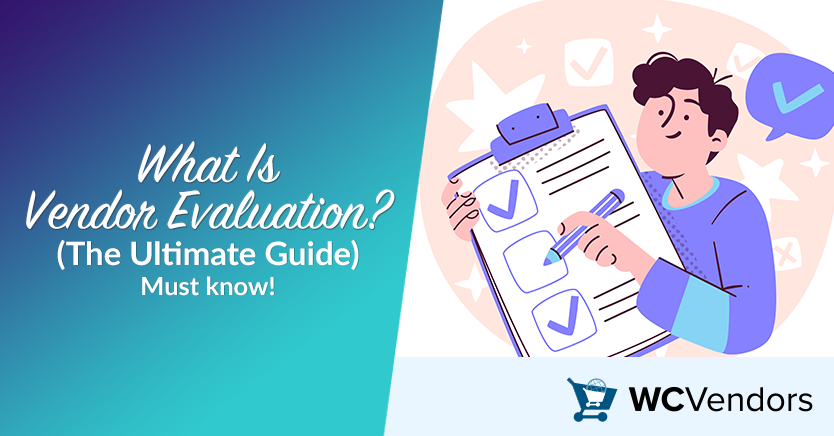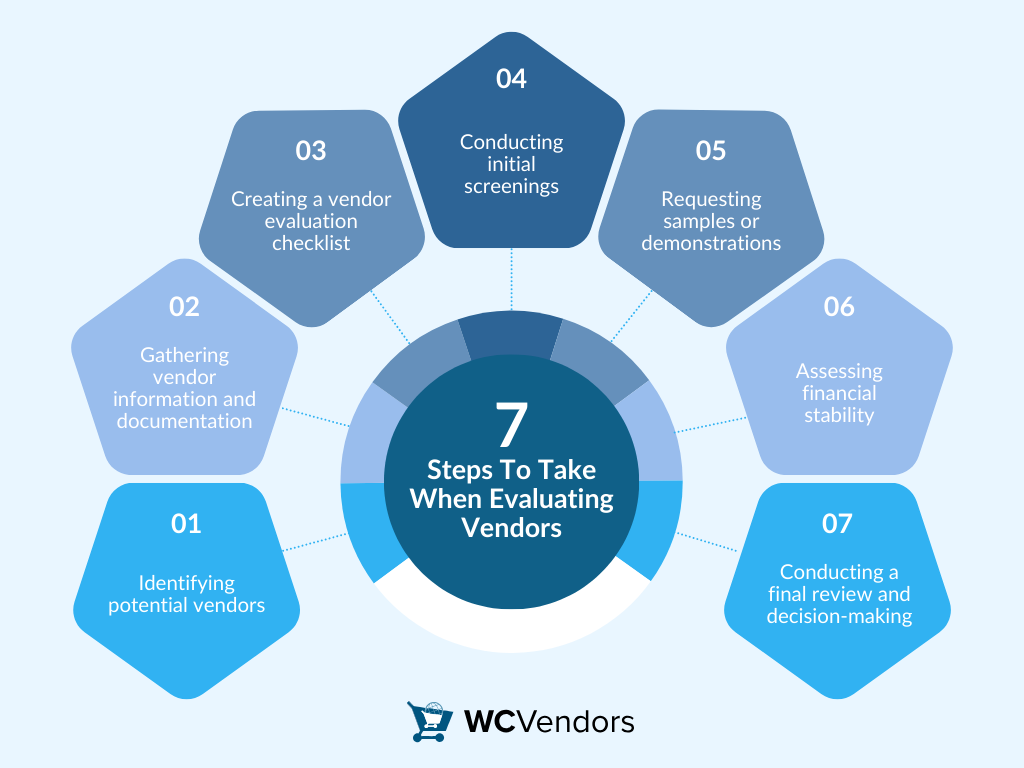
Ever wondered how to choose the right vendors for your marketplace? In the world of multi-vendor platforms, selecting the best vendors is key to your success. But what is vendor evaluation? It’s the process of assessing and choosing vendors based on specific criteria to ensure they meet your business needs.
Understanding what is vendor evaluation and implementing it effectively can make a significant difference in your marketplace’s performance. This guide will walk you through everything you need to know about vendor evaluation, from its importance to how to apply it in your marketplace.
Curious to know more? Let’s dive in!
What Is Vendor Evaluation?
Vendor evaluation is when you check if potential or current vendors are a good fit for your marketplace. It means looking at different parts of a vendor’s business. For example, you check the quality of their products, how they price them, how long it takes for them to deliver, and if they are generally reliable.
Understanding what vendor evaluation is can make a huge difference in the success of your marketplace. By evaluating vendors, you ensure that you are partnering with reliable and trustworthy businesses. This, in turn, helps maintain the quality and reputation of your marketplace.
Why Is Vendor Evaluation Important In Multi-Vendor Marketplaces?
Vendor evaluation is a crucial part of managing a successful multi-vendor marketplace. After all, it helps you choose the right partners who can meet your standards and expectations.
By evaluating vendors carefully, you can achieve several goals. First, you ensure that your marketplace offers high-quality products and services. Then, you maintain strong vendor relationships. Finally, you protect your brand’s reputation.
Let’s explore why vendor evaluation is so important.

1. Ensuring quality and reliability
Vendor evaluation is crucial in multi-vendor marketplaces. First, it ensures the products or services are of high quality. Secondly, it guarantees their reliability. When you carefully evaluate your vendors, you can be confident that your customers will receive high-quality products on time.
2. Building strong vendor relationships
Vendor evaluation also plays a crucial role in building strong and lasting relationships with your vendors. By regularly assessing their performance and working together to address any issues, you can create a partnership based on trust and mutual benefit.
3. Protecting your brand reputation
Your marketplace’s reputation is everything. Partnering with unreliable vendors can lead to negative customer experiences, which can harm your brand. Through vendor evaluation, you can protect your brand’s reputation by only working with vendors who meet your standards.
Understanding the importance of vendor evaluation is just the beginning. Next, we need to identify the specific criteria that can ensure each vendor meets your marketplace’s standards for quality and reliability.
Let’s explore the key factors to consider in vendor evaluation. Read on further!
What Are The Criteria For Vendor Evaluation?
When evaluating vendors for your marketplace, it’s important to consider various criteria to ensure you partner with the right businesses. Each detail matters a lot in figuring out if a vendor will work well with your marketplace and help it do well.
When evaluating vendors, it’s important to consider several key criteria. Let’s break them down:
1. Quality of products or services
Vendor product and service quality is vital for customer satisfaction and marketplace reputation. For physical products, focus on durability, safety, design, and environmental standards. Meanwhile, digital offerings should excel in UI/UX, reliability, compatibility, security, and performance, including speed and uptime.
Checking these features is key to making sure your customers are happy and that your marketplace can stand out from the competition.
2. Pricing and cost-effectiveness
Choosing vendors based on pricing is important. You need to find a good mix of low cost and high quality to offer the best value. It’s not merely about the lowest prices but achieving the best quality-to-price ratio.
For example, vendors can have problems when the cost of materials changes and affects the price of their products. Also, software companies might have to change their prices if they update their licenses or add new features. Effective pricing strategies must account for cost fluctuations and feature updates, adapting accordingly. Promotional pricing and volume discounts can help maintain cost-effectiveness. These approaches attract new customers and reward loyalty, ensuring prices align with the value provided.
3. Delivery and turnaround times

On-time delivery is crucial for keeping customers happy and operations running smoothly. It’s important to assess a vendor’s track record for delivering products when needed. Take a retailer prepping for the holiday rush as an example; they need their holiday line delivered in advance.
Delays can lead to lost sales and unhappy customers. Thus, ensuring that vendors can reliably meet delivery schedules is key to maintaining a professional, trustworthy marketplace.
4. Compliance with regulations
Vendors must comply with all relevant regulations, including industry standards, safety protocols, and legal requirements. This ensures that your marketplace operates within the law. For example, a vendor selling food must meet health and safety standards. These standards are enforced by regulatory bodies to prevent contamination and avoid legal actions.
By sticking to these regulations, your marketplace maintains its credibility. It also earns consumer trust by ensuring every product sold meets high safety and quality criteria.
5. Communication and customer service
Effective communication and strong customer service are vital in addressing any issues that may arise. A vendor who is responsive and easy to work with can help prevent small problems from becoming big ones.
6. Vendor reputation and reviews
It’s important to evaluate the vendor’s industry reputation. Check reviews and feedback from other businesses to measure their reliability and performance. Research can involve browsing online forums or reading industry articles. Positive feedback usually means the vendor is committed to quality and professionalism, impacting your choice significantly.
With a clear understanding of the criteria for vendor evaluation, you’re well on your way to making informed decisions. But how do you put these criteria into practice? Let’s explore the practical steps involved in the vendor evaluation process!
What Are the Steps To Take When Evaluating Vendors?
Evaluating vendors is essential for maintaining the quality and smooth operation of your multi-vendor marketplace. This detailed process involves several steps designed to assess potential partners’ capabilities, reliability, and fit with your business goals.
Here’s a breakdown of the key steps in the vendor evaluation process:
1. Identifying potential vendors
When we begin looking for new vendors, first we need to know what our marketplace wants. This includes the kind of products or services we need, how good the service should be, and how much we can spend. Once we understand our needs, we can start searching. We use online lists, go to trade shows, and talk to people in the business to make a list of possible vendors.
Next, we take a closer look at what each vendor offers, their prices, and if they can give us products or services regularly. We also consider their location and how easy it is to work with their technology. Additionally, we check if they meet the rules and standards of our industry.
2. Gathering vendor information and documentation
Gather all the important info from vendors by requesting detailed product books. These should list items, their codes, full details, and include pictures. Get price sheets that explain how much things cost and if there are any special deals for buying a lot at once.
Make sure the vendors show they follow the rules and standards for your type of business by giving you their certificates. Also, ask for examples of their work with other clients to see how good they are. This info will help you decide if a vendor is right for your marketplace.
3. Creating a vendor evaluation checklist
To properly check each vendor, your list should cover what products they offer and how clear their pricing is. It should also assess if they meet required standards and evaluate their reliability. First, make sure they give you a detailed list of products with SKU numbers, clear descriptions, and pictures.
Prices should be easy to understand and show if there are discounts for buying a lot. They also need to have the right certificates to prove they follow the standards. Finally, see how good they are by looking at what past clients say about them or by checking case studies. This will tell you if they are trustworthy and if their customers are happy.
Vendor evaluation checklist:
- Detailed product catalogs
- Transparent pricing & discounts
- Certifications & standards compliance
- Proven track record & reliability
- Quality of customer support
4. Conducting initial screenings
Start by doing an interview to vendors to learn what they sell. Then, use questionnaires to gather more information. This way, you can figure out who fits your project best. It makes choosing easier and faster.
5. Requesting samples or demonstrations
Request samples or demonstrations of the vendor’s products or services. This allows you to assess the quality firsthand.
6. Assessing financial stability
It’s important to check if a vendor has a strong financial background. This tells us if they can steadily supply what we need. To find this out, we look at how well they handle money and if they can keep going when times get tough. We can do this by looking at their financial reports or credit scores.
These checks help us feel confident in relying on them for our business needs. These documents highlight the vendor’s financial health, such as profit, debt, and revenue patterns.
7. Conducting a final review and decision-making
Finally, conduct a comprehensive review of all the information you’ve gathered and make your decision. Choose vendors who meet your criteria and align with your marketplace’s goals.
Tools And Methods Used In Vendor Evaluation

Selecting the right vendors is key to your business’s success. In this section, we’ll explore effective tools and methods for vendor evaluation. Let’s explore some of them:
1. In-depth analysis and scoring methods
In-depth analysis and scoring methods mean giving vendors a number score for key areas like quality, price, delivery, and customer service. First, decide which areas matter most to you and give them a bigger weight in the scoring. Next, create a scoring system and use surveys, performance data, and feedback to rate each vendor. Finally, calculate the vendor’s total score by adding up the scores after considering their weights. This gives you a straightforward way to compare how vendors are doing.
Key steps:
- Identify and weight critical performance criteria.
- Rate vendors using a numerical scoring system.
- Calculate overall scores for a comparative analysis.
2. Utilizing vendor scorecards
Vendor scorecards are a great way to keep track of ongoing performance. They provide a visual representation of how well each vendor is meeting your expectations. Scorecards combine numerical data and narrative feedback to provide a holistic view of supplier effectiveness. Furthermore, they help identify areas of excellence and those requiring improvement.
Key components:
- Quality and compliance metrics
- Delivery and responsiveness ratings
- Cost and pricing evaluations
- Customer service feedback
- Trend analysis and improvement areas
While tools and methods in vendor evaluation streamline the procurement process and enhance decision-making, they also bring forth several challenges.
Let’s explore these common obstacles in the next section, and find out how to effectively navigate through them. Read on further!
Common Challenges In Vendor Evaluation
While vendor evaluation is essential, it’s not without its challenges. Understanding and managing these issues is key to making the process work smoothly. Here are some common challenges you might face:
1. Managing a large pool of vendors
Evaluating a large number of vendors can be overwhelming. It’s important to stay organized and prioritize your evaluations.
2. Balancing cost with quality
Finding the right balance between cost and quality can be tricky. Remember, the cheapest option isn’t always the best.
3. Overcoming biases in evaluation

Biases can creep into the evaluation process, affecting your judgment. It’s crucial to remain objective and stick to your criteria.
4. Keeping the evaluation process efficient
Vendor evaluation can be time-consuming. Using the right tools and staying focused on key criteria can help streamline the process.
Ongoing Vendor Performance Evaluation And Best Practices
Vendor evaluation is not a one-time task; it requires ongoing monitoring to ensure that your vendors continue to meet your marketplace’s needs. Regular performance reviews help you check how well vendors are doing and make any necessary adjustments. Using key performance indicators (KPIs) is essential for tracking vendor performance over time. They make it easier to spot areas that need improvement.
When issues arise, it’s important to address them quickly and work with the vendor to find solutions. If a vendor consistently falls short, it may be time to re-evaluate or even replace them to maintain the quality of your marketplace.
To ensure that your vendor evaluation process is both effective and efficient, consider the following best practices:
- Build a transparent and fair evaluation process: Ensure that your evaluation process is clear and fair to all vendors. This approach fosters trust and accountability.
- Involve stakeholders in decision-making: Engage key stakeholders in the evaluation process to gain diverse perspectives. This will help you make more informed decisions.
- Leverage technology for efficient evaluations: Use technology to streamline the evaluation process. This makes it easier to track and assess vendor performance.
- Maintain clear and open communication: Keep communication lines open with your vendors. This helps build strong, collaborative relationships.
Combining ongoing performance evaluation with best practices maintains high standards in your multi-vendor marketplace. It also helps in building strong, lasting partnerships with your vendors.
Conclusion
To truly excel in managing your multi-vendor marketplace, understanding what vendor evaluation is and implementing it effectively are crucial steps. This guide has walked you through various aspects of vendor evaluation, highlighting its importance and how to apply it.
To ensure you’re on the right track, let’s review the key points covered:
- What is vendor evaluation? Understanding the process and its impact on marketplace performance.
- Why is vendor evaluation important in multi-vendor marketplaces? The significance of maintaining quality, building strong relationships, and protecting your brand.
- What are the criteria for vendor evaluation? Key factors like product quality, pricing, delivery times, and vendor reputation.
- What are the steps to take when evaluating vendors? Detailed steps including identifying vendors, gathering information, and making decisions.
- Tools and methods used in vendor evaluation like scoring systems and vendor scorecards.
- Common challenges in vendor evaluation such as managing a large vendor pool and balancing cost with quality.
- Ongoing vendor performance evaluation and best practices to maintain high standards and build strong vendor relationships
By integrating these practices into your vendor management strategy, you’ll ensure that your marketplace thrives with high-quality vendors and strong partnerships. If you have any questions, we’re here to assist you!

